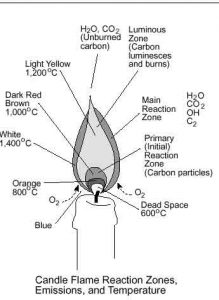BS”D
Joining the Marine [Park] Core!
The Flame’s the Name of the Motzoei Shabbos Game—Or, Variety is the Heart of Heat!
Rabbi Hillel L. Yarmove
Chanukah may now be just a flickering and indistinct memory; after all, we are moving apace toward Tu BiShvat. But really, we do have a fiery light show every week at the conclusion of our holy Shabbos, thanks to the havdalah ceremony.
I am referring, of course, to the flames of the traditionally torch-like havdalah candle.
Speaking of which: You might remember the difference of opinion between Beis Hillel and Beis Shammai (Mesichta Berachos 52b) regarding the nusach of the brachah over a havdalah candle. Beis Shammai maintains that the blessing is “borei me’or ha-eish,” while Beis Hillel avers that the proper formula is “borei me’orei ha-eish.” What is the reason underlying this fundamental machlokess? Beis Shammai hold that the flame of the candle (or avukah [torch] in this case) is actually a one-color fire, but Beis Hillel disagree and insist that it is a fire of many colors (see Rashi there). As usual, we pasken like Beis Hillel.
 It seems that a close look at an ordinary candle flame (but not at a Bunsen-burner flame!) will indeed show you the parti-colored nature of a flame. Not only that, but scientists have measured the heat of various part of an ordinary flame — and these temperatures vary greatly. Wow!
It seems that a close look at an ordinary candle flame (but not at a Bunsen-burner flame!) will indeed show you the parti-colored nature of a flame. Not only that, but scientists have measured the heat of various part of an ordinary flame — and these temperatures vary greatly. Wow!
Now I could tell you which part of the flame is the hottest — and it is not the very tip. And I could even declare that the “coolest” part of the flame is near the wick — and that there is some kind of correlation between these two aspects. But I am not a scientist: I am a mechaneich, and I just can’t help but wonder what mussar we could all learn from the fact that a flame appears to have quite an intricate composition of various colors and temperatures.
Maybe just this:
It takes all parts of a candle flame to produce the heat and the light that we have hitherto taken for granted. Yes, I think I now see the light: Even if someone — say, a talmid or talmidah — is lacking hislahavus (enthusiasm: please note that the Hebrew word for “flame” [“lahav”] is ensconced in this word!), he or she is nevertheless an absolutely necessary component if the aggregate flame of Klal Yisrael is to function effectively. And also please note that even though every individual is different—just like the colors and temperatures vary in different parts of a flame—such individuality is crucial to the existence and robustness of a bona-fide fiery, spiritual Yiddishkeit.
Fantastic!
 And so, as we prepare to fire up our havdalah “torches” here in Marine Park at the beginning of Motzoei Shabbos, let us keep in mind that it is this very variegation and diversity of the ascendant flames which make their fire exude a pure and holy radiance.
And so, as we prepare to fire up our havdalah “torches” here in Marine Park at the beginning of Motzoei Shabbos, let us keep in mind that it is this very variegation and diversity of the ascendant flames which make their fire exude a pure and holy radiance.
Indeed, what a powerful source of enlightening encouragement this thought is to every one of us at the inception of an otherwise mundane work week!
>>>>>>>>>>>>>>>>>>>>>>>>>>>>>>>>>>>>>>>>>>>>>>>>>>>>>
Questions or comments? Please send these to me at hillyarm@yeshivanet.com.
You must be logged in to post a comment.